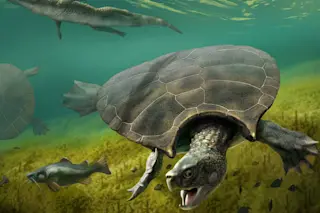Since the 1970s, scientists have pulled bits of fossilized turtle shells from the ground in Central and South America. These were no ordinary hard cases: These shells were impossibly long, indicating turtles stretching about 8 feet from tail to tip.
What else this massive turtle looked like, or how it behaved, remained mostly a mystery for decades. But thanks to a new analysis of the animal's various remains — and the discovery of the longest complete shell yet — paleontologists now have a better idea of how this megaturtle, called Stupendemys geographicus, navigated the marshy Americas 13 million years ago.
Described in the journal Science Advances, the longest S. geographicus shell ever found is over 9 feet long. Massive horns protruding from the front of the shell might mean that male turtles got into fights. And the jawbone found alongside it let paleontologists draw up theories about what the freshwater ...














